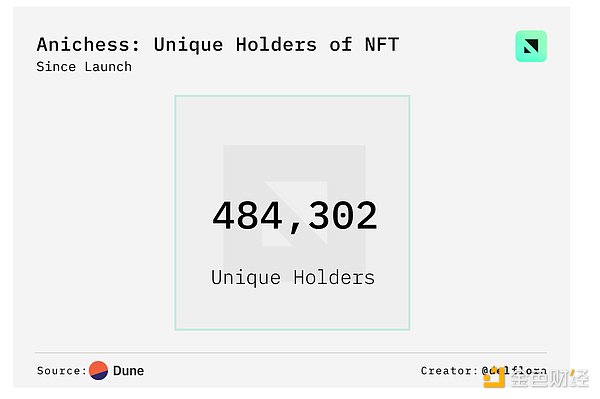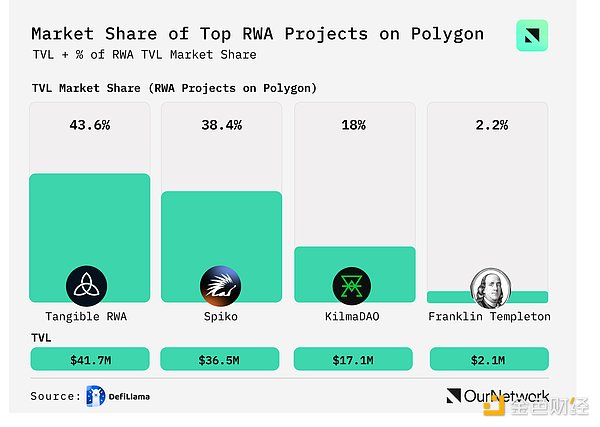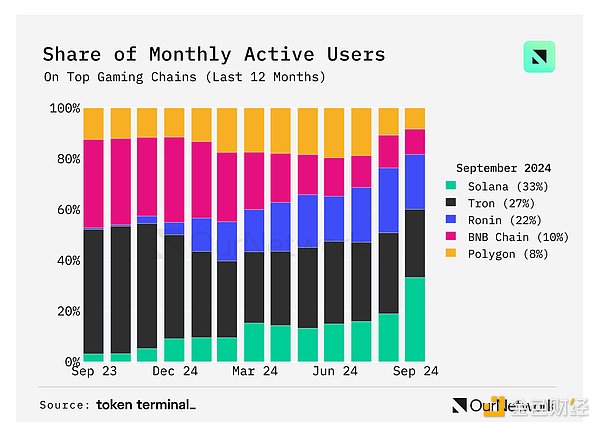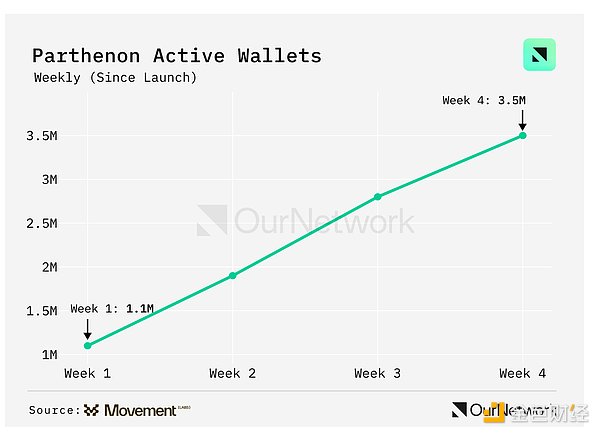Source: OurNetwork Translation: Shan Ouba, Golden Finance
This article will introduce Polygon, a network that is well-known in the crypto space, but many people may not understand the clarity that its on-chain data can provide. The Polygon protocol was launched on the mainnet in 2017 and has gone through three cycles and achieved tremendous development, always being a technological pioneer in the field. There are multiple layers in the Polygon stack that support mature DeFi, gaming, DePIN, and mainstream consumer ecosystems, as well as key technologies designed to solve the deep-rooted fragmentation problems in the web3 field:
Polygon PoS: An EVM-compatible proof-of-stake layer 2, it is the main chain for dApp builders and users in the Polygon ecosystem.
Polygon zkEVM: An EVM-compatible zero-knowledge layer 2 designed to facilitate lower-cost, higher-throughput, and secure transactions.
Polygon CDK: The Chain Development Kit (CDK) enables developers to build their own custom zero-knowledge-powered layer 2.
AggLayer: Aims to help solve the blockchain fragmentation problem by letting any sovereign L1/L2 connect to the network and securely share liquidity, users, and state.
With all that, let us bring you the data-driven story behind Polygon and its ecosystem!
User Trends
Polygon continues to grow: two-thirds of MATIC upgraded to POL, and its stablecoin market cap increased by another $389 million
In the first 10 days of September, Polygon averaged 660,000 daily active addresses (DAA) and 3 million daily transactions. On September 4, the MATIC ➡ POL migration began - users upgraded more than 66% of MATIC to POL in 6 days. POL replaced MATIC and introduced the concept of "super high-yield tokens" that can be used to provide valuable services to any chain in the Polygon network (including AggLayer itself).

Polygon's stablecoin market capitalization almost doubled in 10 months, from $1.1 billion to $2.1 billion. This is mainly due to the growth of USDC and USDT market capitalization. In particular, Polygon's USDT market capitalization doubled from $473 million to $945 million in 10 months.

Polygon facilitated more than $7.8 billion in NFT sales through 28 million transactions. NFT sales in July and August were $1.3 billion and $1.2 billion, respectively, and NFT sales in the past two months also set a record high in 2024.


So far this year, Polygon has attracted $2.8 billion in funds into its blockchain, including 92% ($2.57 million) came from Ethereum mainnet, 1.77% ($49.34 million) from Arbitrum, and 1.36% ($37.79 million) from Solana. The blockchain experienced $2.5 billion in outflows, bringing Polygon’s net inflows to +$300 million year-to-date. These long-term net positive inflows strongly indicate real demand for services in the Polygon ecosystem.

Infrastructure
Polygon Infrastructure hosts 22 DePIN projects, Fox (over 600,000 pieces of content) and Immutable zkEVM (over 74 million transactions)
Polygon is a major gathering place for infrastructure projects such as DePIN and AI. Its DePIN field covers 19 different categories of projects with a market value of US$432 million. The DePIN space on Polygon shows considerable diversity, including 7 projects in the sensor space, 3 projects in the wireless space, and 3 projects in the energy space, among others. DePIN transaction volume also grew by more than 500% from May 2023 to May 2024.

A key infrastructure for Polygon PoS is Fox Verify, a search engine designed to allow users to verify ownership of content on the Internet. Fox currently has more than 670,000 pieces of content stored on its protocol, with more than 1.1 million Uniform Resource Identifier (URI) updates to date.


Immutable zkEVM 是一条由 Polygon The dedicated gaming blockchain powered by Ethereum technology is a critical infrastructure in the Web3 gaming ecosystem. Since its launch, it has attracted 6.8 million active wallets and conducted 73 million transactions. Its total locked value (TVL) has risen to $14.3 million, up 178% in the past 90 days

Polygon POS Protocol Coverage
Polygon PoS Overview
With over 2 million weekly active addresses, 20 million weekly transactions, and $887 million in TVL, the Polygon PoS (Proof of Stake) chain remains the preferred destination for builders and users in the Polygon ecosystem.
Polygon PoS is also home to many of the industry’s most used applications, covering DePIN (DIMO), games (Anichess), entertainment (Fox Verify, Courtyard), prediction markets (Polymarket, Azuro) - one of the few mainstream breakout use cases in the industry this year - which we will explore below.
This past week, the Polygon PoS native token also migrated from MATIC to POL. Since the start of September 4, more than 66.8% of MATIC has been migrated.

Polymarket
Polymarket Breaks Out: Trading Volume Reached $859M in July and August, TVL Will Break Through the $100M Mark in August 2024
Polymarket is a decentralized betting platform for real-world events on Polygon. Polymarket’s volume surged to $859 million in July and August, a 44x increase from the average through 2024. As political tensions rise and crypto milestones approach, users flock to the betting venue — Polymarket’s TVL broke through the $100 million cap in August, climbing to $103.9 million by August 22. That’s a $32 million surge in just 12 days. Polymarket’s TVL accounts for 83% of the entire prediction market’s TVL.

The 2024 presidential election winner market dominated, attracting $84.1 million in August alone, while total bets reached $606.1 million. Clearly, politics is the theme of the game for the 2024 prediction market, and both recent and long-term data highlight the popularity of this area among bettors.

In 2024, Polymarket's user base grew exponentially. The number of new users surged from 646 in the first week of January to 5,200 in mid-August. In just over 7 months, the total user base expanded from 42,445 to 128,393, an increase of 202%. Although the most popular, Polymarket is just one of many emerging prediction markets running on Polygon PoS.

Courtyard
Courtyard NFT Soars: Daily Trading Volume Surges, and NFTs Minted Will Reach 116,000 by August 2024
Courtyard is an on-chain collectibles trading platform. By mid-2024, daily transactions surged to over 3,000, peaking at 9,509 on August 7. This exponential growth has persisted since December 2023, with minted NFTs increasing from ~2.7K per month to over 30K in July. Pokémon cards dominated trading, with 33K worth $1.6M sold in August alone, bringing cumulative Pokémon card sales to over $6.1M.

Courtyard's cumulative user base has now exceeded 6,200 people. More notably, as of the latest data, the platform has attracted 14,601 independent minters (creators). The substantial growth in overall users and content creators shows that Courtyard has a strong appeal to both collectors and artists.

Pokemon accounts for 71% of traded assets, and collectible "Pokemon" dominates Courtyard's market. While Pokemon cards dominate, the platform also offers basketball collectibles as well as other sports products. Secondary market activity reached $80,000 at its peak, indicating that liquidity is increasing.


Anichess
The number of users of Anichess increased significantly in the third quarter, reaching 2.838M
Anichess, a chess-based strategy game that blends traditional gameplay with magic elements, has 2.838M users and a cyclical growth pattern. The platform has seen a 700% increase in weekly active wallets to over 120K in Q3 2024, with a 5.6% new user rate and 3.2% daily active user rate. Meanwhile, transaction volume has surged to 5-8x the baseline. This volatility, coupled with a 28x increase in daily transaction volume from $50 to $14K, suggests that the game design drives intense cyclical engagement.

Anichess has a very diverse user base and high engagement: of the 484,000 unique holders, 22.7% of wallets hold more than 20 NFTs, 5.9% of wallets hold 11 to 20, and 5.4% of wallets hold 7 to 10. Interestingly, 22% of holders own exactly 3 Anichess NFTs. This distribution suggests that there are advanced users and newcomers, with periodic catalysts driving mass participation.


Anichess maintains growth despite fluctuations in trading costs: Despite soaring fees, the total number of platform users grew to 283.8 10,000, with a new user rate of 5.59% and a daily active user rate of 3.189%. This suggests that its value proposition is stronger than the network cost, which may be due to its unique game mechanics.

DIMO
DIMO delivers 107,000 vehicles: Tesla leads with 20.2% market share
DIMO is an open connected car platform that uses data to benefit drivers and has attracted more than 20 car brands. Tesla leads the pack with 20.2% market share, having recently become the first automaker to officially support DIMO with direct integration. Tesla is followed by Kia (15.6%), Chevrolet (10.0%), and Ford (9.7%). This broad appeal across the automotive sector highlights DIMO’s broad adoption and potential for valuable cross-brand data aggregation.

The benefits vary across manufacturers. Tesla led the electric vehicle market with 22,700 units sold and $17.6 million in revenue. Luxury brands like Porsche made higher revenues at lower volumes (2.1k/unit), while mass-market brands like Kia (17,500 units, $115/unit) focused more on volume than unit profit. DIMO rewards highlight Tesla’s dominance: 4.1K users issued DIMO rewards per week 353K tokens. Economy brands such as Kia and Chevrolet performed well, while niche and luxury brands also saw consistently high participation. This pattern suggests that the ecosystem for many automotive segments within the platform is growing.

Polygon RWAs
Polygon PoS ranks second with 23 RWAs tokenized assets, worth $531.58 million

There are clear sector preferences in the RWA ecosystem: real estate accounts for 56.9% of token value, followed by private equity (30%), commodities (7.3%), and government securities (5.7%). Notable tokens include HLEOVUS in private equity ($6 million) and BENJI in government securities ($2.14 million).

At the protocol level, Tangible RWA has a significant impact, with a total risk value of $41 million and 218 tokenized assets, accounting for 43% of Polygon's total RWA value. It is followed by Spiko with $36 million and Klima DAO with $10 million, further illustrating the diverse ecosystem that is taking shape on the Polygon blockchain.

AggLayer Overview
Polygon is becoming an aggregated blockchain network through AggLayer, an interoperability solution that connects sovereign chains into a network of unified liquidity and shared state. The solution aims to connect multiple chains with zero-knowledge security to achieve more scalable cross-chain interoperability, including Polygon's PoS chain, which may be connected to AggLayer, making its TVL and users directly interoperable with all other connected chains.
Currently, AggLayer is in build mode, with a recent cross-chain demo showing a working version of what the Polygon Labs team and other core AggLayer contributors plan to accelerate in the coming months: chain-to-chain communication.
Teams from across the industry are working to create a positive-sum network of connected chains. These include contributions from Espresso Systems, OKX, Irreducible, Gateway, Succinct Labs, Nodekit, Movement Labs, Union, and more.
Let’s explore some of the data behind popular chains built on Polygon AggLayer.
Ronin
Ronin Daily Active Addresses Reach 2.3M, 100x Growth in One Year
Ronin (an EVM-compatible L1 focused on supporting the gaming industry) is building a zkEVM L2 using Polygon CDK, which will connect to the AggLayer, you can learn more about it here. Ronin is a dedicated gaming blockchain that aims to be the best place to build, grow, and monetize web3 games. In the Layer 1 category, DAU is consistently ranked in the top 5, and the percentage share has grown from 0.6% to 22% due to the creative design of on-chain mechanisms (such as daily check-ins to get reward boosts). Ronin focuses on premium addresses that spend on-chain. While we’ve seen 2-3x growth since 2023, off-chain spending is not being recorded — Pixels reports over 100,000 active VIPs spending $10/month.


Mavis Market is the premier NFT marketplace on Ronin, facilitating primary sales and secondary peer-to-peer transactions. Mavis Market grew 16 times, with peak monthly trading volume increasing from $368,000 in 2023 to $6.15 million in 2024. NFT Launchpad has achieved 5 near-instant sellouts, raising over 3 million RON.

Lumiterra, a multiplayer open-world survival crafting game, ran a 20-day closed beta, generating $810,000 in RON in the marketplace through items that are essential to player progression. Lumiterra is the latest proof of the Ronin Effect - Ronin's curation and promotion of quality games for the community is a proven way to drive massive growth.

Movement Labs
Movement Labs surpasses 100 million transactions in its incentivized testnet program
Movement is building a parallelized Move-EVM layer 2 solution that will connect to Polygon's AggLayer. Specifically, the integration will connect the MoveVM rollup to the AggLayer ecosystem, expanding its capabilities and reach.


Some of Movement’s flagship projects, such as Echelon, Meridian, and Routex, also grew. Echelon reached 943.9K weekly trades and 923K weekly deposits, while Meridian facilitated 869K swaps. Routex also recorded 12K weekly trades.
 JinseFinance
JinseFinance
 JinseFinance
JinseFinance JinseFinance
JinseFinance JinseFinance
JinseFinance JinseFinance
JinseFinance Beincrypto
Beincrypto Finbold
Finbold Crypto Potato
Crypto Potato Cointelegraph
Cointelegraph 链向资讯
链向资讯 Cointelegraph
Cointelegraph